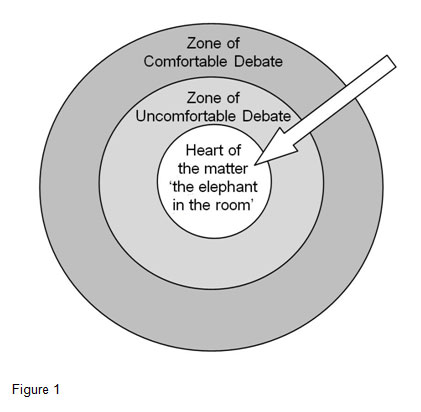In the last of the series, John Blakey explores the concept of the ZOUD – the zone of uncomfortable debate. The concept of the ZOUD underpins all aspects of the FACTS approach which demands the use of ‘edgier’ coaching skills.
In previous articles, the FACTS coaching approach was explored as a means of adopting the ‘edgier’ coaching skills that drive performance as well as building relationships in the post-recession environment. All of the FACTS coaching skills – feedback, accountability, challenge, tension and systems thinking can involve breaking the rapport with the coachee in order drive for ‘bottom-line’ results. This breaking of rapport requires courage to initiate and feels uncomfortable. The purpose of this final article in the series is to explore this ‘zone of uncomfortable debate’ (ZOUD) and understand how it can be used effectively to leverage a coaching relationship.
Let us first consider how conversations and interactions take place and look at a model developed by Professor Cliff Bowman at Cranfield University (Bowman, 1995). Consider Figure 1 below – the centre of the diagram represents the core of the issue, the ‘elephant in the room’, which once resolved provides the key to making a breakthrough.

When a coaching conversation begins there is typically a period of small talk, rapport building, developing an understanding of common ground, etc. This is where the conversation is easy, it feels relaxed and there is not a lot of tension. This stage of the conversation is straightforward and can be referred to as the zone of comfortable debate.
However, if this conversation is to be more than a social chat, there is usually a matter at the heart of the discussion. The parties have come together for a purpose – to agree action, to make a decision, to resolve a problem, etc. To achieve this, the conversation may have to move to a zone of uncomfortable debate. In this zone there is a feeling of increased tension and the pressure starts to build. What often happens is that the individuals feel the tension, find it uncomfortable and, fearing the pressure will permanently damage the relationship, the conversation moves back out to the zone of comfortable debate. The tension is diffused and the rapport is maintained, but the matter at hand has not been resolved.
The heart of the issue is a bit like having an ‘elephant in the room’. Here is something enormous that is taking up significant space. However, the ‘elephant’ is not dealt with directly as it is such a big and difficult thing. Perhaps we don’t want to make the elephant angry in case it damages the whole house, or maybe we are too polite to comment on it? Often coaches and coachees find innovative and creative ways to move around the ‘elephant’, to manage it and live with it. Until they face up to the fact that there is actually an ‘elephant in the room’ and try to remove it directly, the situation will remain unchanged. Facing up to this fact and dealing with it is going to be uncomfortable.
Coaches often work in difficult areas of personal development. If these areas were simple to understand and easy to resolve, the person would not need a coach, they would have simply done it themselves. Often coaching is about holding a mirror up and showing the coachee something they do not want to see and have avoided up to now. Coaching is about challenging assumptions, examining habits, overcoming barriers and embedding change. For this to work the coach must feedback, challenge and hold the coachee accountable and be prepared to go into the ZOUD. All the components of the FACTS approach require the coach to enter the ZOUD more often, more skilfully and with the total belief this is in the best long-term interest of the coaching relationship and the wider organisational system.
The courage of the coach
There are risks associated with this; through the tension of the ZOUD the coaching relationship could be irreparably damaged. The coach may feel that there is a risk of rapport being lost and so releases the tension, moving the conversation back to the benign zone of comfortable debate. So there is an elaborate dance of dialogue that takes place around the core issue. There is one step into the ZOUD and then a step back into the zone of comfortable debate, and the dance continues without addressing the issues. A more constructive strategy is for the coach to stick with the tension and accept it as positive.
Some coaches may have difficulty with this concept. As a coach you believe you are there to serve the coachee, holding them in unconditional positive regard, with all your coaching training emphasising the importance of rapport and not being directive. Sometimes, wanting to be the peacemaker, a coach may feel the need to maintain harmony and find ‘common ground’ and so diffuse the tension by going back into the zone of comfortable debate and creating innovative strategies to approach the subject in a different way that is less tense. In the FACTS approach the challenge is for the coach is to stay in the ZOUD. At the heart of this is the importance of a coach holding direct communication as opposed to directive communication.
So what will enable a coach to enter and work with the ZOUD? This is about the courage of the coach. High potential individuals are typically robust and able to hold strong debate. The coach is there to serve the coachee and the organisation sponsoring the coaching, and so any intervention will be designed to be positive and constructive. The coach feels tension and has the courage to sustain this in the interest of helping the coachee unlock a breakthrough. If they do this then the coachee, not the coach, is asked to take responsibility for diffusing the tension. They tap into the latent energy of the tension and use it to make a transformative shift. If the coaching relationship has been built on trust and mutual respect it will be strong enough to sustain surprising levels of tension and so benefit from facing rather than avoiding the heart of the issue.
The concept of the ZOUD and being comfortable to enter the ZOUD as a coach is fundamental to all the components of the FACTS approach. Whether it be in delivering feedback, holding accountability, challenging or creating constructive tension, a coach using the FACTS approach will need to be aware of the ZOUD and be able to consciously enter into it when the situations demands.
To work further with the ideas raised in this article you may find it useful to reflect on the following questions:
- Reflect on a time when have you entered the ZOUD – what happened?
- When have you held the tension, and when have you diffused it – what does this tell you?
- What core assumptions do you hold about tension and the importance of rapport?
- What is the difference between direct and directive communication?
- What are the conditions that will enable you as a coach to enter the ZOUD and work within it?
In the last of the series, John Blakey explores the concept of the ZOUD – the zone of uncomfortable debate. The concept of the ZOUD underpins all aspects of the FACTS approach which demands the use of 'edgier' coaching skills.
In previous articles, the FACTS coaching approach was explored as a means of adopting the 'edgier' coaching skills that drive performance as well as building relationships in the post-recession environment. All of the FACTS coaching skills – feedback, accountability, challenge, tension and systems thinking can involve breaking the rapport with the coachee in order drive for 'bottom-line' results. This breaking of rapport requires courage to initiate and feels uncomfortable. The purpose of this final article in the series is to explore this 'zone of uncomfortable debate' (ZOUD) and understand how it can be used effectively to leverage a coaching relationship.
Let us first consider how conversations and interactions take place and look at a model developed by Professor Cliff Bowman at Cranfield University (Bowman, 1995). Consider Figure 1 below - the centre of the diagram represents the core of the issue, the ‘elephant in the room’, which once resolved provides the key to making a breakthrough.

When a coaching conversation begins there is typically a period of small talk, rapport building, developing an understanding of common ground, etc. This is where the conversation is easy, it feels relaxed and there is not a lot of tension. This stage of the conversation is straightforward and can be referred to as the zone of comfortable debate.
However, if this conversation is to be more than a social chat, there is usually a matter at the heart of the discussion. The parties have come together for a purpose - to agree action, to make a decision, to resolve a problem, etc. To achieve this, the conversation may have to move to a zone of uncomfortable debate. In this zone there is a feeling of increased tension and the pressure starts to build. What often happens is that the individuals feel the tension, find it uncomfortable and, fearing the pressure will permanently damage the relationship, the conversation moves back out to the zone of comfortable debate. The tension is diffused and the rapport is maintained, but the matter at hand has not been resolved.
The heart of the issue is a bit like having an ‘elephant in the room’. Here is something enormous that is taking up significant space. However, the ‘elephant’ is not dealt with directly as it is such a big and difficult thing. Perhaps we don't want to make the elephant angry in case it damages the whole house, or maybe we are too polite to comment on it? Often coaches and coachees find innovative and creative ways to move around the ‘elephant’, to manage it and live with it. Until they face up to the fact that there is actually an ‘elephant in the room’ and try to remove it directly, the situation will remain unchanged. Facing up to this fact and dealing with it is going to be uncomfortable.
Coaches often work in difficult areas of personal development. If these areas were simple to understand and easy to resolve, the person would not need a coach, they would have simply done it themselves. Often coaching is about holding a mirror up and showing the coachee something they do not want to see and have avoided up to now. Coaching is about challenging assumptions, examining habits, overcoming barriers and embedding change. For this to work the coach must feedback, challenge and hold the coachee accountable and be prepared to go into the ZOUD. All the components of the FACTS approach require the coach to enter the ZOUD more often, more skilfully and with the total belief this is in the best long-term interest of the coaching relationship and the wider organisational system.
The courage of the coach
There are risks associated with this; through the tension of the ZOUD the coaching relationship could be irreparably damaged. The coach may feel that there is a risk of rapport being lost and so releases the tension, moving the conversation back to the benign zone of comfortable debate. So there is an elaborate dance of dialogue that takes place around the core issue. There is one step into the ZOUD and then a step back into the zone of comfortable debate, and the dance continues without addressing the issues. A more constructive strategy is for the coach to stick with the tension and accept it as positive.
Some coaches may have difficulty with this concept. As a coach you believe you are there to serve the coachee, holding them in unconditional positive regard, with all your coaching training emphasising the importance of rapport and not being directive. Sometimes, wanting to be the peacemaker, a coach may feel the need to maintain harmony and find ‘common ground’ and so diffuse the tension by going back into the zone of comfortable debate and creating innovative strategies to approach the subject in a different way that is less tense. In the FACTS approach the challenge is for the coach is to stay in the ZOUD. At the heart of this is the importance of a coach holding direct communication as opposed to directive communication.
So what will enable a coach to enter and work with the ZOUD? This is about the courage of the coach. High potential individuals are typically robust and able to hold strong debate. The coach is there to serve the coachee and the organisation sponsoring the coaching, and so any intervention will be designed to be positive and constructive. The coach feels tension and has the courage to sustain this in the interest of helping the coachee unlock a breakthrough. If they do this then the coachee, not the coach, is asked to take responsibility for diffusing the tension. They tap into the latent energy of the tension and use it to make a transformative shift. If the coaching relationship has been built on trust and mutual respect it will be strong enough to sustain surprising levels of tension and so benefit from facing rather than avoiding the heart of the issue.
The concept of the ZOUD and being comfortable to enter the ZOUD as a coach is fundamental to all the components of the FACTS approach. Whether it be in delivering feedback, holding accountability, challenging or creating constructive tension, a coach using the FACTS approach will need to be aware of the ZOUD and be able to consciously enter into it when the situations demands.
To work further with the ideas raised in this article you may find it useful to reflect on the following questions:
- Reflect on a time when have you entered the ZOUD - what happened?
- When have you held the tension, and when have you diffused it - what does this tell you?
- What core assumptions do you hold about tension and the importance of rapport?
- What is the difference between direct and directive communication?
- What are the conditions that will enable you as a coach to enter the ZOUD and work within it?





